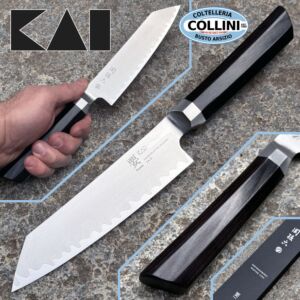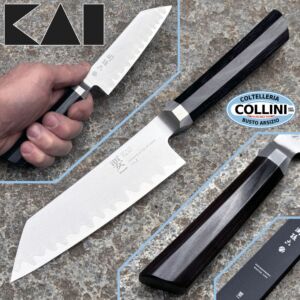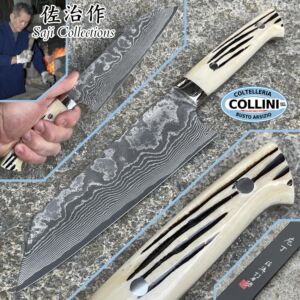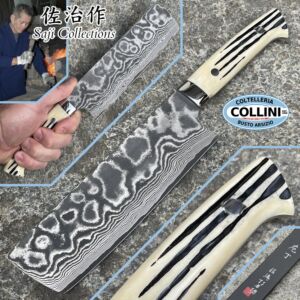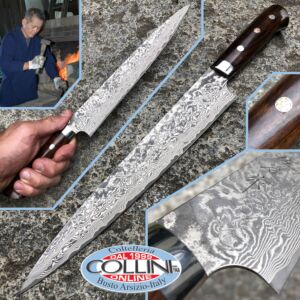Knives and Kitchen Accessories
-
Kai Japan - Seki Magoroku Kaname - AE-5502 - Kiritsuke 19.5cm. - professional kitchen knife
The core of Kaname blades is made of an extremely durable VGXeos steel with a hardness of 60-62 (±1) HRC, rolled in two layers of stainless steel. The special manufacturing method ensures an incredibly thin cutting edge that reduces friction during use. This results in excellent and durable sharpness, promoting filigree, smooth and precise cuts.
To best design the handle, we combined the experiences of professionals and consumers. The result is a black-grained pakkawood handle that creates a seamless transition from the handle to the tang. The octagonal, ergonomic shape of the handle provides good control while cutting, while the knife rests securely and comfortably in the hand.
Blade: VGXeos rolled stainless steel with a hardness of 60/62±1 HRC
Country of manufacture: Japan
Handle: pakkawood
Blade length: 195mm.
Handle length: 130mm.
Blade thickness: 1.5mm.
Total length: 325mm.
Weight: 160g.
Care and maintenance: hand wash only - keep sharp with a fine-grained sharpening steel or sharpening stone of at least grit #3000AE-5502 -
Kai Japan - Seki Magoroku Kaname - AE-5501 - Kiritsuke 15cm. - professional kitchen knife
The core of Kaname blades is made of an extremely durable VGXeos steel with a hardness of 60-62 (±1) HRC, rolled in two layers of stainless steel. The special manufacturing method ensures an incredibly thin cutting edge that reduces friction during use. This results in excellent and durable sharpness, promoting filigree, smooth and precise cuts.
To best design the handle, we combined the experiences of professionals and consumers. The result is a black-grained pakkawood handle that creates a seamless transition from the handle to the tang. The octagonal, ergonomic shape of the handle provides good control while cutting, while the knife rests securely and comfortably in the hand.
Blade: VGXeos rolled stainless steel with a hardness of 60/62±1 HRC
Country of manufacture: Japan
Handle: pakkawood
Blade length: 150mm.
Handle length: 130mm.
Blade thickness: 1.5mm.
Total length: 280mm.
Weight: 134g.
Care and maintenance: wash by hand only - keep sharp with a fine-grained sharpening steel or a sharpening stone of at least grit #3000AE-5501 -
Kai Japan - Seki Magoroku Kaname - AE-5500 - Kiritsuke 12cm. - professional kitchen knife
The core of Kaname blades is made of an extremely durable VGXeos steel with a hardness of 60-62 (±1) HRC, rolled in two layers of stainless steel. The special manufacturing method ensures an incredibly thin cutting edge that reduces friction during use. This results in excellent and durable sharpness, promoting filigree, smooth and precise cuts.
To best design the handle, we combined the experiences of professionals and consumers. The result is a black-grained pakkawood handle that creates a seamless transition from the handle to the tang. The octagonal, ergonomic shape of the handle provides good control while cutting, while the knife rests securely and comfortably in the hand.
Blade: VGXeos rolled stainless steel with a hardness of 60/62±1 HRC
Country of Manufacture: Japan
Handle: pakkawood
Blade length: 120mm.
Handle Length: 130mm.
Blade thickness: 1.5mm.
Total length: 250mm.
Weight: 78g.
Care: wash by hand only
Maintenance: keep sharp with a fine-grained sharpening steel or a sharpening stone of at least grit #3000AE-5500 -
Kai Japan - Shun Kohen Anniversary - TBS-0220 - Limited Edition Luxury Set - kitchen knives
With the two Kohen knives, the Japanese company once again demonstrates its great expertise in producing high-quality kitchen knives. The "Coreless" Damascus blade is made from VG2 and VG10 high-performance stainless steels that are forged and folded to produce 72 layers that alternate sequentially on the edge of the blade to ensure unmatched cutting and edge-holding performance.
A premium material such as pakkawood in red and black colorations was chosen for the handles. Also included in the set are two leather blade protector sheaths and an aluminum case for storing and transporting these two valuable knives safely.
Blade: Japanese Coreless rolled stainless steel - 72 alternating layers of VG10 and VG2 at 60±2 HRC
Handle: Pakkawood
Kitchen knife blade length: 200mm.
Petty/utility knife blade length: 150mm.
Sheaths: leather, for use as blade covers
Packaging: aluminum case with warranty certificates
Edition: numbered and limited to 3000 pieces worldwide
Maintenance: hand wash only, do not wash in dishwasherTBS-0220 -
Kyocera - Utility Knife 11cm - KyoTop Ceramic Made in Japan - KT-110-HIPD - kitchen knife
Winner of the prestigious and international Good Design Award 2001 for the originality and functionality of its design.
- 11 cm black Ishi-Ba Sandgarden HIP ceramic blade. worked with motifs that recall those of Japanese karesansui and subjected to High Isostatic Pressing (HIP). Suitable for cutting fruit, vegetables, small meats
- Wooden handle
Quality made in Japan since 1984With Kyocera ceramic knives, cooking becomes pure pleasure. Their special features:
- ultra-sharp zirconia ceramic blade, hand ground
- extremely robust and corrosion resistant blade
- high-tech material with excellent resistance to wear
- absolute cutting precision thanks to the smooth and compact surface of the blade
- maximum lightness and extreme practicality thanks to the ergonomic handleThe Ten Secrets of Ishi-Ba:
* does not carry tastes and smells
* is made of inert material
* does not cause chemical reactions with food
* avoids unpleasant flavors of metal
* does not rust
* does not deteriorate
* has no oxidizable parts
* it is easy to wash, just rinse it
* it is very light and easy to handle
* stays perfectly sharp, even for yearsThe origin of the management of the Kyocera Group is the Kyocera philosophy, a life philosophy based on the real life experiences and rules of thumb of Kazuo Inamori, founder and president emeritus of Kyocera Corporation. With the question "What is the right thing to do as a human being?" as a primary criterion, Kyocera's philosophy describes the significance of striving for proper management and acting in accordance with human ethical and moral values and fundamental social norms.
BEFORE USING THE KNIFE, READ THESE INSTRUCTIONS CAREFULLY AND KEEP THEM
This knife will work for several years without any problems if:
• Removes it from the knife holder or drawer
• Uses it for straight cuts to be made on a cutting board
• Washes and dries it
• Puts it back into the knife holder or drawer after useUSE
Ideal for cutting boneless fruit, vegetables and meats
The term vegetables and fruit is generic: not all types of fruit or vegetables that are not recommended can be listed, but it is strictly not recommended to use them on dutra fruit and vegetables (pumpkin, coconuts, etc.)
Always use a plastic or wooden cutting board; avoid cutting on marble, stone, plates or tiles To chop, separate and de-bone, as well as to cut hard, frozen foods, bread with crust and cheeses, you always use your traditional steel knives. These types of cuts require bending and twisting and, for this reason, it is better to use a more flexible material than ceramic.
For its protection, the tip and base of the blade are not sharpCLEANING
Hand wash with water and dish soap.
Kyocera ceramic knives with plastic handles are dishwasher safe. They should be placed in the compartment dedicated to ladles and small accessories in the upper basket, avoiding contact with other metal utensils. Kyocera ceramic knives with wooden handles are not dishwasher safe.
If discoloration occurs that does not go away with normal cleaning, wash the blade (not the handle) with a mild bleach solution.TO AVOID
Do not drop on hard surfaces.
Do not use the tip as a pivot point, the sharp end could penetrate the cutting board, get stuck and break Do not expose the blade to direct flame (ceramic is a heat conductor). Do not use the side of the blade to crush garlic or other foods.STORAGE
You place it in a knife holder, sheath or drawer. When placing or removing the knife from the holder, be careful not to damage the tip of the blade.USURY
Over time, all knives lose their sharpness. A soft metal (stainless steel) blade "slips" when it loses its sharpness. Harder metals (such as carbon steel) stay sharp longer, but lose sharpness differently. Harder materials, instead of "slipping", tend to chip slightly.
In the beginning, the ceramic is sharper - and stays sharp for longer. Over time, small incisions may occur on the lo of the blade. This is the normal process whereby all hard material blades lose their sharpness.
Despite their appearance, the existence of small incisions does not necessarily mean that the knife is not sharp. You may find that it works flawlessly over an extended period of time.
When the performance of the knife is no longer the desired one, the Kyocera sharpening process will ensure that your knife returns to having a well-sharpened blade.KT-110-HIPD -
Takeshi Saji - Bunka Knife 180mm in deer horn - VG-10 32 layers - vegetable kitchen knife
Takeshi Saji was born in 1948 in Takefu (Fukui prefecture), a city located roughly in the center of Japan and in the heart of an area for centuries devoted to the production of blades. His workshop is still there, built around the oven thanks to which, for several years now, Takeshi Saji has been forging steel (especially damascus) with which he makes various models of traditional Japanese knives. The choice of materials for the finishes (mainly natural), the essential lines - evocative of use - and the chromatic combinations of rare impact make his creations unique and unmistakable in the panorama of world cutlery and, at home, they have earned him the prestigious title of Maestro.
Intended use: vegetable knife
Type of production: Artisan
Production Lama: Japan
Blade: Hand forged, laminated damascus with 32-layer VG10 steel edge
Handle: in deer horn
Blade length: 180mm.
Blade thickness: 2.5mm.
Total length: 305mm.
Weight: 236g.
Packaging: Cardboard box
Notes: the knife is entirely handmade by Takeshi SajUse and maintenance
- Do not cut bones or frozen. The blade can chip or break.
- Hand wash with warm water and towel dry.
- Use stones for sharpening and maintenance of the blade.TS-BUN-H -
Takeshi Saji - Nakiri Knife 170mm in corno di cervo - VG-10 a 32 strati - coltello cucina verdure
Takeshi Saji was born in 1948 in Takefu (Fukui prefecture), a city located roughly in the center of Japan and in the heart of an area for centuries devoted to the production of blades. His workshop is still there, built around the oven thanks to which, for several years now, Takeshi Saji has been forging steel (especially damascus) with which he makes various models of traditional Japanese knives. The choice of materials for the finishes (mainly natural), the essential lines - evocative of use - and the chromatic combinations of rare impact make his creations unique and unmistakable in the panorama of world cutlery and, at home, they have earned him the prestigious title of Maestro.
Intended use: vegetable knife
Type of production: Artisan
Production Lama: Japan
Blade: Hand forged, laminated damascus with 32-layer VG10 steel edge
Handle: in deer horn
Blade length: 170mm.
Blade thickness: 2.5mm.
Total length: 300mm.
Weight: 260g.
Packaging: Cardboard box
Notes: the knife is entirely handmade by Takeshi SajUse and maintenance
- Do not cut bones or frozen. The blade can chip or break.
- Hand wash with warm water and towel dry.
- Use stones for sharpening and maintenance of the blade.TS-NAK-H -
Takeshi Saji - Sujihiki Knife 240mm with Desert Ironwood Handle - SPG2 Damascus - kitchen knife
Takeshi Saji was born in 1948 in Takefu (Fukui prefecture), a city located roughly in the center of Japan and in the heart of an area for centuries devoted to the production of blades. His workshop is still there, built around the oven thanks to which, for several years now, Takeshi Saji has been forging steel (especially damascus) with which he makes various models of traditional Japanese knives. The choice of materials for the finishes (mainly natural), the essential lines - evocative of use - and the chromatic combinations of rare impact make his creations unique and unmistakable in the panorama of world cutlery and, at home, they have earned him the prestigious title of Maestro.
Intended use: kitchen knife, meat, fish
Type of production: Artisan
Production Lama: Japan
Blade: Hand forged, laminated damascus with SPG2 sintered steel edge (63 hrc)
Handle: Desert Ironwood
Blade length: 235mm.
Blade thickness: 2.5mm.
Total length: 365mm.
Weight: 200g.
Packaging: Wooden box
Notes: the knife is entirely handmade by Takeshi SajUse and maintenance
- Do not cut bones or frozen. The blade can chip or break.
- Hand wash with warm water and towel dry.
- Use stones for sharpening and maintenance of the bladeTS-SUJ -
Kyocera - Santoku Knife 14cm - Ceramica KyoTop Made in Japan - KT-140-HIPD - coltello da cucina
Vincitore del prestigioso ed internazionale Good Design Award 2001 per l'originalità e la funzionalità del suo design.
- Lama in ceramica Ishi-Ba Sandgarden HIP nera di 14 cm.
- Manico in legno
Qualità made in Japan dal 1984
Con i coltelli in ceramica Kyocera cucinare diventa puro piacere. Le loro speciali caratteristiche:
- lama in ceramica di zirconia ultra-tagliente, molata a mano
- lama estremamente robusta e resistente alla corrosione
- materiale high-tech con ottima tenuta del filo all'usura
- assoluta precisione di taglio grazie alla superficie liscia e compatta della lama
- massima leggerezza ed estrema praticità grazie al manico ergonomico
I dieci segreti di Ishi-Ba:
* non trasporta gusti ed odori
* è di materiale inerte
* non provoca reazioni chimiche con gli alimenti
* evita sapori sgradevoli di metallo
* non arrugginisce
* non si deteriora
* non ha parti ossidabili
* è facile da lavare, basta sciacquarlo
* è leggerissimo e maneggevole
* rimane perfettamente affilato, anche per anni
L'origine della gestione del Gruppo Kyocera è la filosofia di Kyocera, una filosofia di vita basata sulle esperienze della vita reale e sulle regole empiriche di Kazuo Inamori, fondatore e presidente emerito di Kyocera Corporation. Con la domanda "Qual è la cosa giusta da fare come essere umano?" come criterio principale, la filosofia di Kyocera descrive il significato dell'impegno per una gestione corretta e dell'agire in conformità con i valori umani etici e morali e le norme sociali fondamentali.
PRIMA DI UTILIZZARE IL COLTELLO LEGGA ATTENTAMENTE QUESTE ISTRUZIONI E LE CONSERVI
Questo coltello funzionerà per vari anni senza nessun problema se:
• Lo toglie dal supporto per coltelli o dal cassetto
• Lo utilizza per tagli diritti da eseguire su tagliere
• Lo lava e l'asciuga
• Lo rimette nel supporto per coltelli o nel cassetto dopo averlo utilizzato
USO
Ideale per tagliare frutta, verdure e carni senza osso
Il termine verdure e frutta è generic: non si possono elencare tutti i tipi di frutta o verdura sconsigliati,ma è tassativamente sconsigliato l’utilizzo su frutta e verdura dutra (zucca, noci di cocco, ecc, )
Utilizzi sempre un tagliere di plastica o legno; eviti di tagliare su marmo, pietra, piatti o piastrelle Per trinciare, separare e disossare, così come per tagliare alimenti duri, congelati, pane con crosta e formaggi, utilizzi sempre i suoi coltelli tradizionali in acciaio. Questi tipi di taglio richiedono flessione e torsione e, per questo motivo, conviene utilizzare un materiale più flessibile rispetto alla ceramica.
Per la sua protezione, la punta e la base della lama non sono affilate
PULIZIA
Lavare a mano con acqua e detersivo per piatti.
I coltelli in ceramica Kyocera con manico in plastica possono essere messi in lavastoviglie. Vanno riposti nel vano dedicato a mestoli e piccoli accessori nel cestello superiore, evitando il contatto con altri utensili in metallo. I coltelli in ceramica Kyocera con manico in legno non possono essere lavati in lavastoviglie.
Nel caso si producessero scolorimenti che non scompaiono con la normale pulizia, lavi la lama (non l'impugnatura) con una leggera soluzione a base di candeggina.
EVITARE
Non lasciare cadere su superci dure.
Non utilizzare la punta come punto di rotazione, l'estremità a§lata potrebbe penetrare nel tagliere, bloccarsi e rompersi Non esporre la lama alla amma diretta (la ceramica è un conduttore di calore). Non utilizzare la parte laterale della lama per schiacciare aglio o altri alimenti.
CONSERVAZIONE
Lo collochi in un supporto per coltelli, un fodero o un cassetto. Quando colloca o toglie il coltello dal supporto, faccia attenzione a non danneggiare la punta della lama.
USURA
Con il trascorrere del tempo tutti i coltelli perdono l'a§latura. Un lama di metallo dolce (acciaio inossidabile) "slitta" quando perde l'affilatura. I metalli più duri (come l'acciaio con carbonio) rimangono affilati più tempo, però perdono l'affilatura in modo diverso. I materiali più duri, invece di "slittare", tendono a scheggiarsi leggermente.
All'inizio la ceramica è più affilata - e rimane a§lata per più tempo. Con il trascorrere del tempo possono prodursi delle piccole incisioni sul lo della lama. Si tratta del processo normale per il quale perdono l'a§latura tutte le lame in materiale duro.
Nonostante la loro apparenza, l'esistenza di piccole incisioni non signica necessariamente che il coltello non sia a§lato. Potrà constatare che funziona perfettamente durante un periodo di tempo prolungato.
Quando il rendimento del coltello non sarà più quello desiderato, il processo di a§latura Kyocera farà si che il suo coltello torni ad avere un lama ben affilata.
È possibile che le incisioni più profonde e una punta rotta si possano risolvere grazie alla nuova affilatura.KT-140-HIPD -
ExtremaRatio - Waki Satin - XXV Anniversarium - 150pcs. Limited Edition - knife
WAKI XXV ANNIVERSARIUM LIMITED EDITION is a limited series version of only 150 pieces that keeps all the features of the famous Waki model intact.
This product is an elaboration of the Japanese Wakizashi sword, a typical blade 30 to 60 centimeters long, which the Samurai always carried in contact with the body, where the Katana was carried exclusively in battle.
The blade has the classic Japanese Tanto profile and is made of Böhler N690 steel with heat treatments that raise its hardness to 58 HRC for the best combination of edge hold and strength. The blade, with flat rounding, features a precious satin finish.
The handle, in black coloring, is made of Forprene while The black-colored Cordura sheath is equipped with a MOLLE system that ensures safe carrying of the razor-sharp blade by protecting it from shocks that could reduce its efficiency.
WAKI XXV ANNIVERSARIUM LIMITED EDITION comes in an IP67-certified watertight Polypropylene technical case with pressurization valve that is weather, dust and shock resistant. Also inside is a metal plaque with the numbering of the limited series of 150 and a commemorative coin of the twenty-fifth Extrema Ratio anniversary.
Intended Use: Collection / Tactical / Machete
Production type: Industrial
Country of manufacture: Italy
Blade: N690Co stainless steel at 58HRC
Blade Treatment: Satin finish
Handle: Forprene
Blade Length: 297mm.
Blade thickness: 6.5mm. tapering to 4mm from the handle.
Total length: 456mm.
Weight: 384g.
Sheath: cordura, compatible with M.O.L.L.E. systems.
Packaging: polypropylene case with numbered metal plaque and commemorative coin with Extrema Ratio logos
Notes: Limited and numbered edition made in only 150 piecesER-WA-XXV -
Takeshi Saji - Black Damascus Steak knife - SPG2 Damascus and Micarta - handmade knife
Takeshi Saji was born in 1948 in Takefu (Fukui prefecture), a city located roughly in the center of Japan and in the heart of an area for centuries devoted to the production of blades. His workshop is still there, built around the oven thanks to which, for several years now, Takeshi Saji has been forging steel (especially damascus) with which he makes various models of traditional Japanese knives. The choice of materials for the finishes (mainly natural), the essential lines - evocative of use - and the chromatic combinations of rare impact make his creations unique and unmistakable in the panorama of world cutlery and, at home, they have earned him the prestigious title of Maestro.
Intended use: table / sports / collection
Type of production: Artisan
Production Lama: Japan
Blade: Hand forged, laminated damascus with 15-layer SPG2 steel edge
Handle: in black G10
Blade length: 100mm.
Blade thickness: 2.5mm.
Total length: 240mm.
Weight: 80g.
Packaging: Cardboard box and leather sheath
Notes: The knife is handmade by Takeshi SajiTS-BDS-SPG2 -
Takeshi Saji - Sujihiki Knife 240mm in deer horn - VG-10 32 layers - meat kitchen knife
Takeshi Saji was born in 1948 in Takefu (Fukui prefecture), a city located roughly in the center of Japan and in the heart of an area for centuries devoted to the production of blades. His workshop is still there, built around the oven thanks to which, for several years now, Takeshi Saji has been forging steel (especially damascus) with which he makes various models of traditional Japanese knives. The choice of materials for the finishes (mainly natural), the essential lines - evocative of use - and the chromatic combinations of rare impact make his creations unique and unmistakable in the panorama of world cutlery and, at home, they have earned him the prestigious title of Maestro.
Intended use: kitchen knife, meat, fish
Type of production: Artisan
Production Lama: Japan
Blade: Hand forged, laminated damascus with 32-layer VG10 steel edge
Handle: in deer horn
Blade length: 235mm.
Blade thickness: 2.5mm.
Total length: 370mm.
Weight: 233g.
Packaging: Cardboard box
Notes: the knife is entirely handmade by Takeshi SajUse and maintenance
- Do not cut bones or frozen. The blade can chip or break.
- Hand wash with warm water and towel dry.
- Use stones for sharpening and maintenance of the blade.TS-SUJ-H -
Takeshi Saji - Sakura Petty Rainbow Damascus - 135mm - kitchen knife
Takeshi Saji was born in 1948 in Takefu (Fukui prefecture), a city located roughly in the center of Japan and in the heart of an area for centuries devoted to the production of blades. His workshop is still there, built around the oven thanks to which, for several years now, Takeshi Saji forges steel (especially damascus) with which he makes various models of traditional Japanese knives. The choice of materials for the finishes (mainly natural), the essential lines - evocative of use - and the chromatic combinations of rare impact make his creations unique and unmistakable in the panorama of world cutlery and, at home, they have earned him the prestigious title of Master.
The blade is equipped with a central plate in Blue Steel carbon steel coated on the sides with layers of steel, brass and copper plates that help to increase the resistance to oxidation and resilience.
Once again, Master Saji has succeeded in creating an innovative new art style for his knives, combining the traditional "Sakura-Maki" handle and the striking rainbow Damascus blade.
The Petty is a small utility knife used for peeling, shaping, slicing fruit and vegetables, chopping herbs and making side dishes.
Intended use: utility knife, meat, fish, vegetables
Type of production: Artisan
Production Lama: Japan
Blade: Hand forged, in laminated damascus with Blue Steel carbon steel cutting edge (63 hrc) and side plates in stainless steel, copper and brass
Handle: Desert Ironwood
Blade length: 135mm.
Blade thickness: 2.5mm.
Total length: 245mm.
Weight: 131g.
Packaging: Wooden box
Notes: the knife is entirely handmade by Takeshi SajUse and maintenance
- Do not cut bones or frozen. The blade can chip or break.
- Hand wash with warm water and towel dry.
- Use stones for sharpening and maintenance of the blade.TS-ETTY -
Takeshi Saji - Chef's Bunka Knife 180mm with Desert Ironwood Handle - SPG2 Damascus - kitchen knife
Takeshi Saji was born in 1948 in Takefu (Fukui prefecture), a city located roughly in the center of Japan and in the heart of an area for centuries devoted to the production of blades. His workshop is still there, built around the oven thanks to which, for several years now, Takeshi Saji forges steel (especially damascus) with which he makes various models of traditional Japanese knives. The choice of materials for the finishes (mainly natural), the essential lines - evocative of use - and the chromatic combinations of rare impact make his creations unique and unmistakable in the panorama of world cutlery and, at home, they have earned him the prestigious title of Master.
Intended use: kitchen knife, meat, vegetables, fish
Type of production: Artisan
Production Lama: Japan
Blade: Hand forged, laminated damascus with SPG2 sintered steel edge (63 hrc)
Handle: Desert Ironwood
Blade length: 180mm.
Blade thickness: 2.5mm.
Total length: 303mm.
Weight: 239g.
Packaging: Wooden box
Notes: the knife is entirely handmade by Takeshi Saj
Use and maintenance- Do not cut bones or frozen. The blade can chip or break.
- Hand wash with warm water and towel dry.
- Use stones for sharpening and maintenance of the blade.TS-R2 -
Chris Reeve - Sikayo - 6.5" Santoku - Kitchen Knife
Uso Consigliato: verdura, carne cruda, pesce
Produzione: Idaho, USA
Lama: in acciaio inox CPM-S35VN con finitura Silver PVD
Taglio: di tipo asimmetrico, non adatta a mancini
Lunghezza Lama: 165mm.
Lunghezza Totale: 286mm.
Impugnatura: Ultem 1000 (un particolare polimero incredibilmente resistente ad abrasioni e ad alte temperature)
Spessore Lama: 3.8mm.
Peso: 179g.12428 -
Takeshi Saji - Santoku Kitchen Chef with Maki-e Art - kitchen knife
Takeshi Saji - Santoku Kitchen Chef with Maki-e Art - kitchen knife
Use: kitchen knife, meat, vegetables, fish
Type of production: Artisan
Production Lama: Japan
Blade: Forged by hand, damask laminate with edge Hitachi Shirogami to 64HRC
Handle: lacquered wood and painted by hand
Blade length: 175mm.
Blade thickness: 3mm.
Length closed: -
Overall length: 305mm.
Thick when closed: -
Balancing: -
Weight: 204g.
Sheath: lacquered wood and hand painted
Packaging: Cardboard Box
Note: the knife is made entirely by hand by Takeshi Saji, the painting and the chasing of the sheath is made by Master Kouichiro Tsukada with the ancient technique of Maki-e art.
Use and maintenance
- Do not cut bones or frozen. The blade can chip or break. - Hand wash with warm water and pat dry with towel. - Use stones for sharpening and maintenance of the blade.saji-custom -
Tojiro - Wa-Urushi Murakami Yanagiba 21cm - sfilettare - coltello artigianale
Questi coltelli giapponesi, preziosi gioielli realizzati artigianalmente ed in tiratura limitata, sono caratterizzati dalla meticolosa lavorazione ad intaglio di impugnatura e fodero in legno di quercia laccato denominata "Wa Urushi"
La lama di 21cm è in acciaio laminato con tagliente in acciaio Cromo/Vanadio/Molibdeno a 62HRC e lamine esterne in damasco al Nickel a 63 strati in modo da coniugare un design superlativo ad una capacità di taglio, penetrazione e tenuta del filo senza eguali.Impiego: pesce, sashimi
Paese di produzione: Giappone
Tipo di produzione: artigianale
Lunghezza lama: 21cm
Materiale lama: acciaio laminato 62HRC con damasco esterno a 63 strati
Materiale impugnatura: legno di quercia laccato
Materiale fodero: legno di quercia laccato
Note: fodero ed impugnatura intagliate e lavorate interamente a mano con la tecnica tradizionale del "Wa Urushi"4913€1,221.31Out of stock



